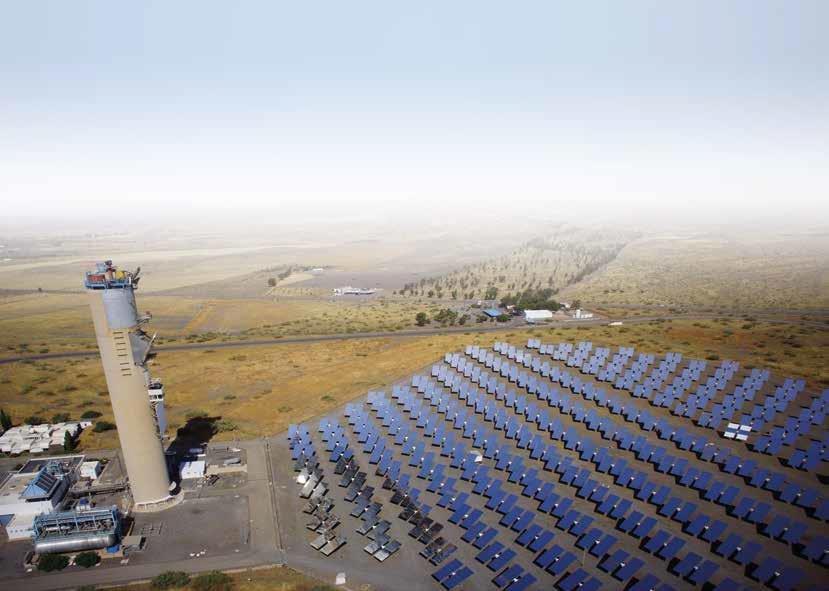Collection of solar energy
Solar irradiation serves as a major energy source for renewable electrical energy. This solar energy can be collected either by direct or indirect methods.
Direct methods convert radiation energy directly into electrical energy, most commonly through photovoltaic effects. Photovoltaic modules consist of a semiconductor material, which generates voltage and current when light is absorbed in its bulk material. Indirect methods instead use solar-thermal technologies, where sunlight is focussed onto an absorbing material that transforms the radiation energy into thermal energy. The thermal energy is then used to power steam turbines, in the same way as fossil-fuel or nuclear power plants.
Solar tower plants
In STPs, solar irradiation is reflected and focussed by an array of mirrors, called ‘heliostats’, onto a receiver installed on an elevated structure, the power tower. The heliostats feature a tracking system in order to focus solar irradiation onto the receiver throughout the day. The receiver absorbs the concentrated solar irradiation and the resulting heat is passed to a heat transfer fluid, which is used for consecutive power generation [Zhang 2013]. Figure 1 shows the layout of an experimental STP at Plataforma Solar de Almería (PSA) in Spain.
Solar extinction measurements
Upscaling the power of STP is conceptually straightforward but a couple of pitfalls have to be avoided. In a best-case scenario, all of the direct irradiation from sunlight captured by the heliostats would be utilized for power generation. A complication of increasing the size of STPs is a comparative increase in solar extinction between the heliostats and the receiver, which limits the efficiency of energy collection. In modern, high power STPs, the heliostat-receiver distance may exceed 1 kilometer, so the solar extinction caused by local parameters such as humidity or particle concentration (i.e. dust) has to be considered when assessing STP performance.
Established methods to analyze solar extinction aim to determine the transmission or scattering coefficients at the local site. There are significant drawbacks to using these methods, including the comparably small measurement volume, or the requirement
to use monochrome light sources. Deriving the solar extinction, as it is occurring in STPs, from such measurements would therefore require extrapolation in spatial and spectral dimensions, which can create large errors.
A new method proposed by Ballestrin et al. employs scientific cameras (ORCA-Flash4.0) as detectors to measure solar extinction. By using the solar signal and a broadband detector, spectral extrapolation can be avoided, yielding more accurate measurements of solar extinction. A simplified diagram of the measurement setup is shown in figure 2.
Taking simultaneous images of a Lambertian target (a target with uniform scattering properties, as determined in [Ballestrin 2018]) with two cameras at different distances, the solar extinction can be derived by the following formula:
With I2 being the intensity observed by camera 2 and I1 by camera 1, the areas observed on the target are identical for both cameras. By knowing the distance ‘D’ between both cameras, the extinction coefficient can be determined using the Beer-Lambert law. From this coefficient, solar extinction can be obtained for each particular heliostat receiver distance applying the law.
In the system developed at PSA, the distance ‘D’ is 742 m which is representative in a low extinction environment such as PSA.
Experimental preconditions for employing this method are the availability of Lambertian targets of high homogeneity and diffusivity, as well as highly linear cameras.
It is desirable to use this method in the process of determining appropriate locations for STPs, as well as during operation, to include the effect of solar extinction into the routine assessment of efficiency (see figure 3).
The method has been applied over one year at Plataforma Solar de Almería, Spain. The results in figure 4 indicate that the solar extinction reached its minimum value and minimum variability during the winter months, while the absolute extinction and its variability peaked during the summer months [Ballestrin 2019].
Conclusion
Solar tower plants rely on a conceptually simple method of energy generation. However, maximizing their performance and thereby providing an efficient method of energy generation is contingent upon having knowledge of important parameters. In this report, two studies by Ballestrin et al., were presented which involve the determination of solar attenuation in STPs. In another study, Ballestrin et al., showed how scientific cameras can be employed to monitor the solar irradiation on the receiver during operation [Ballestrin 2019]. Both methods employed ORCA-Flash4.0 cameras as spatially resolved light detectors, thereby mitigating geometric effects present in commonly employed point detectors. The ORCA-Flash4.0 was the camera of choice for these experiments, as it delivers good linearity and uniformity.
References
Zhang, H. L., et al. “Concentrated solar power plants: Review and design methodology.” Renewable and Sustainable Energy Reviews 22 (2013): 466-481.
Ballestrín, J., et al. “Solar extinction measurement system based on digital cameras. Application to solar tower plants.” Renewable Energy 125 (2018): 648-654.
Ballestrín, J., et al. “One year of solar extinction measurements at Plataforma Solar de Almería. Application to solar tower plants.” Renewable Energy 136 (2019): 1002-1011.
Ballestrín, J., et al. “Diagnosis of a Lambertian target in solar context.” Measurement 119 (2018): 265-269.
Ballestrín, J., et al. “Simplifying the measurement of high solar irradiance on receivers. Application to solar tower plants.” Renewable Energy 138 (2019): 551-561.
Hamamatsu Photonics Deutschland GmbH
Arzberger Str. 10
82211 Herrsching am Ammersee
Telefon: +49 (8152) 375-0
Telefax: +49 (8152) 375-199
http://www.hamamatsu.com
Public Relations
Telefon: +49 (8152) 375-185
Fax: +49 (8152) 375-199
E-Mail: rfritsch@hamamatsu.de
![]()
